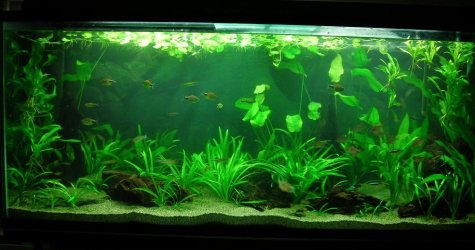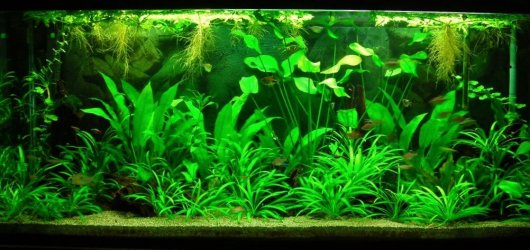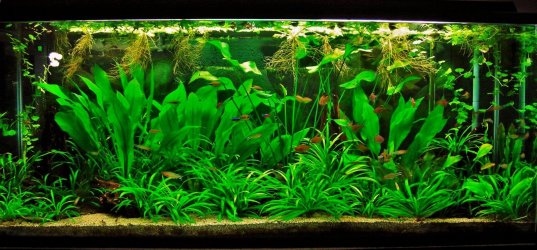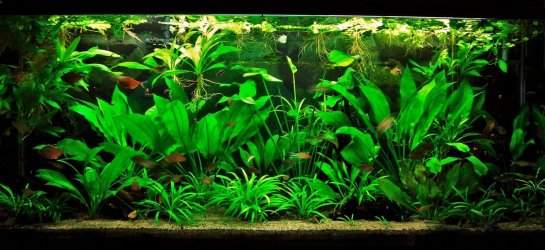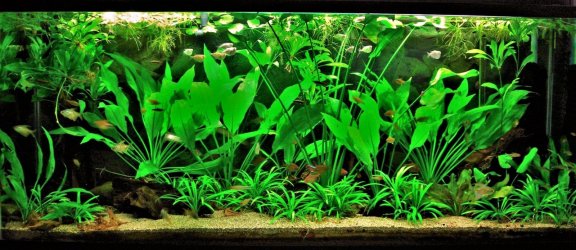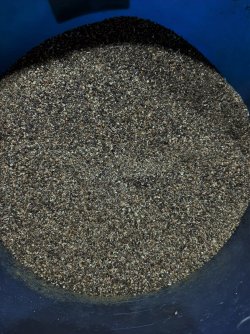What if I need to deep clean the substrate due to lots of build up of detritus?You do not "remove" tabs, they slowly dissolve. I have never "found" a tab I inserted 2-3 months previously. You should not be messing in the substrate that much anyway, that is the most important part of an aquarium, the bacteria bed that keeps the tank healthy.
🌟 Exclusive Amazon Black Friday Deals 2024 🌟
Don’t miss out on the best deals of the season! Shop now 🎁
You are using an out of date browser. It may not display this or other websites correctly.
You should upgrade or use an alternative browser.
You should upgrade or use an alternative browser.
I was dealing with "dirty" looking water. Amazing what a nice substrate cleaning and water change does!
- Thread starter Rocky998
- Start date
What if I need to deep clean the substrate due to lots of build up of detritus?
I think you've got so many different questions in different threads you lose track of the advice members have given. You should not need to dig into the substrate in a normal planted tank, you are risking the most important part of the aquarium's biological system (for both fish and plants). If you are not overfeeding, or overstocking, and if you have substrate-rooted plants with their roots in the substrate (not in pots), you should not have problems with the substrate getting clogged. The sand in the 40g cory tank I posted photos of was not touched in three years, and when I tore that tank down this past Spring to give away, the sand was anything but "dirty."
Remember that root tabs aren't like garden fertiliiser. It's not a capsule full of dirt. The ones I've seen are little balls in a gelatine capsule that dissolves, then the tiny balls slowly break down and release the nutrients. They're designed to break down slowly, not release all of it at once.What if I need to deep clean the substrate due to lots of build up of detritus?
If the cories have dug around a plant or when I've uprooted something, I've had the balls in that spot come to the surface. But it doesn't do anything, doesn't affect the parameters, and I just grab them with aquascaping tweezers an push them back under the plant.
Use aquascaping tweezers, or even normal tweezers, to push the capsule deep under the plant, so it's close to the roots. Even when you deep clean sand, you should be moving around the plants, not shoving the tube through the roots. So stick the capsules under the roots and deep in the substrate, and it's fine. But even if they come to the surface, it's fine. Just stick them back down.
I kinda figured that would be the answer. Wasn't quite sure though.I think you've got so many different questions in different threads you lose track of the advice members have given. You should not need to dig into the substrate in a normal planted tank, you are risking the most important part of the aquarium's biological system (for both fish and plants). If you are not overfeeding, or overstocking, and if you have substrate-rooted plants with their roots in the substrate (not in pots), you should not have problems with the substrate getting clogged. The sand in the 40g cory tank I posted photos of was not touched in three years, and when I tore that tank down this past Spring to give away, the sand was anything but "dirty."
I was going to just plant potted plants into the substrate and not worry about them getting uprooted.
What do you do to keep your plants in place such as swords?
Can I use metal weights? I've asked this before but I have gotten mixed answers.
I kinda figured that would be the answer. Wasn't quite sure though.
I was going to just plant potted plants into the substrate and not worry about them getting uprooted.
What do you do to keep your plants in place such as swords?
Can I use metal weights? I've asked this before but I have gotten mixed answers.
I agree that there are situations when plants may need to be in pots. But it should not be done otherwise because you are removing a very important aspect of a healthy aquarium which begins in the substrate. The other day I posted this as a question because I was interested in the reasoning behind it. Not surprisingly, no one gave any scientific evidence beyond individual preferences. That's fine, but when one is considering an aspect of the aquarium where the biological system will be impacted one way or the other, factual evidence is of more importance than my own preference. Walstad cites a number of studies dealing with the oxygenation of the substrate from rooted plants, and concluded that "the evidence suggests that plant roots have a major impact on sediment ecology, stimulating the processing and recycling of sediment nutrients and toxins. Without the normal root-release of oxygen and organic compounds by aquatic plants, the substrate could become a mulm-ridden 'dead zone'." Sound familiar? Now to your questions here.
Once sword plants are established, most fish will not have any success uprooting them. I am talking smallish fish, not foot-long cichlids. I have used a sand bed of four inches in my 5-foot tank, down to 1.5 or 2 inches in smaller tanks. I push the roots down to the bottom glass, then pile the sand up around the plant. Then very gently pull the crown exactly vertically until it is exposed. Sometimes I have a chunk of wood next to the plant, this is very "natural" as plants often root next to such objects in nature. I sometimes use rounded river rocks.
I would not use metal weights, there may or may not be issues with the metal; it just isn't needed so I won't risk it.
Very informative @Byron, thank you!I agree that there are situations when plants may need to be in pots. But it should not be done otherwise because you are removing a very important aspect of a healthy aquarium which begins in the substrate. The other day I posted this as a question because I was interested in the reasoning behind it. Not surprisingly, no one gave any scientific evidence beyond individual preferences. That's fine, but when one is considering an aspect of the aquarium where the biological system will be impacted one way or the other, factual evidence is of more importance than my own preference. Walstad cites a number of studies dealing with the oxygenation of the substrate from rooted plants, and concluded that "the evidence suggests that plant roots have a major impact on sediment ecology, stimulating the processing and recycling of sediment nutrients and toxins. Without the normal root-release of oxygen and organic compounds by aquatic plants, the substrate could become a mulm-ridden 'dead zone'." Sound familiar? Now to your questions here.
Once sword plants are established, most fish will not have any success uprooting them. I am talking smallish fish, not foot-long cichlids. I have used a sand bed of four inches in my 5-foot tank, down to 1.5 or 2 inches in smaller tanks. I push the roots down to the bottom glass, then pile the sand up around the plant. Then very gently pull the crown exactly vertically until it is exposed. Sometimes I have a chunk of wood next to the plant, this is very "natural" as plants often root next to such objects in nature. I sometimes use rounded river rocks.
I would not use metal weights, there may or may not be issues with the metal; it just isn't needed so I won't risk it.
This helped a ton.
So basically, just plant the Amazon sword all the way down to the glass and then gently pull up to expose the crown?
I want to make sure I have what you are saying correct.
Seachem Flourish root tabs are tablets. Round things about 1/4 inch across and 1/8 tall. They are black in colour. The shape makes them easy to push into the substrate.
Very informative @Byron, thank you!
This helped a ton.
So basically, just plant the Amazon sword all the way down to the glass and then gently pull up to expose the crown?
I want to make sure I have what you are saying correct.
Yes. That makes sure you are down as far as possible, and you make sure the crown is not buried or it will rot. Here are photos of the largest tank I had, the 5-foot 115g. It was set up with fine gravel from 2009 until the switch to play sand in 2011. I had 4-5 inches spread out, then pushed some to the back but of course with normal water flow through the substrate--and believe me, there is water flow through a fine sand substrate--it evened out on its own. The first photo is after set-up August 1, 2011, not very impressive, but the next photos from the following years show how the plants responded; photos are dated. I never once used the water changer on the substrate, I left the housekeeping to the 70 Corydoras and they never failed me. The sand always looked much lighter in tone in photographs, but it was a dark grey mix as shown dry in the last photo.
Attachments
Awesome tank!Yes. That makes sure you are down as far as possible, and you make sure the crown is not buried or it will rot. Here are photos of the largest tank I had, the 5-foot 115g. It was set up with fine gravel from 2009 until the switch to play sand in 2011. I had 4-5 inches spread out, then pushed some to the back but of course with normal water flow through the substrate--and believe me, there is water flow through a fine sand substrate--it evened out on its own. The first photo is after set-up August 1, 2011, not very impressive, but the next photos from the following years show how the plants responded; photos are dated. I never once used the water changer on the substrate, I left the housekeeping to the 70 Corydoras and they never failed me. The sand always looked much lighter in tone in photographs, but it was a dark grey mix as shown dry in the last photo.
Thank you for sharing.
Where did you get grey quikrete play sand? I would get that and mix it with the brown stuff in a heartbeat to give the tank a more natural look!
Awesome tank!
Thank you for sharing.
Where did you get grey quikrete play sand? I would get that and mix it with the brown stuff in a heartbeat to give the tank a more natural look!
Quikrete Play Sand is carried by Lowe's and Home Depot, maybe other places too. It seems there is a dark grey sand and a more natural-looking buff sand, and from what other members have posted back a ways you may find one of the other but not both in a store. My HD has the dark grey. I liked the dark grey very much, though under the tank lighting it did seem much lighter, but when I actually peered down into the tank, it was darker...one of those differences when we view through glass.
Interesting side note, when I was out hiking in the wild University of British Columbia Malcolm Knapp Research Forest last week, I trekked to a spot along Spring Creek that I had not been to in years, just to see the water level, and I turned and saw five unopened bags of Quikrete Play Sand piled next to what looked like a drain cover in the bank. It made me chuckle. Back in 2010 or so I once saw what I assumed were freshwater lobsters in this creek, all white with bright orange pincers at the front. I was never able to photograph them because at the slightest sound or shadow they darted under rocks way too heavy to move.
I will definitely do some browsing! Thanks!Quikrete Play Sand is carried by Lowe's and Home Depot, maybe other places too. It seems there is a dark grey sand and a more natural-looking buff sand, and from what other members have posted back a ways you may find one of the other but not both in a store. My HD has the dark grey. I liked the dark grey very much, though under the tank lighting it did seem much lighter, but when I actually peered down into the tank, it was darker...one of those differences when we view through glass.
Interesting side note, when I was out hiking in the wild University of British Columbia Malcolm Knapp Research Forest last week, I trekked to a spot along Spring Creek that I had not been to in years, just to see the water level, and I turned and saw five unopened bags of Quikrete Play Sand piled next to what looked like a drain cover in the bank. It made me chuckle. Back in 2010 or so I once saw what I assumed were freshwater lobsters in this creek, all white with bright orange pincers at the front. I was never able to photograph them because at the slightest sound or shadow they darted under rocks way too heavy to move.
That is very interesting with those lobsters! I wonder what species they were?
Similar threads
- Replies
- 8
- Views
- 256
- Replies
- 10
- Views
- 515
- Replies
- 3
- Views
- 366
- Replies
- 2
- Views
- 214


